Cmy3701 2021 Study guides, Study notes & Summaries
Looking for the best study guides, study notes and summaries about Cmy3701 2021? On this page you'll find 26 study documents about Cmy3701 2021.
Page 3 out of 26 results
Sort by
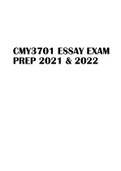
-
CMY3701 ESSAY EXAM PREP 2021 & 2022
- Exam (elaborations) • 35 pages • 2022
-
- R89,00
- + learn more
TABLE OF CONTENT PAGE 1. QUESTION ONE SUTHERLANDS NINE PROPOSITIONS (30 MARKS) 2. QUESTION TWO SOCIAL DISORGANISATION CHICAGO SCHOOL (30 MARKS) 3. QUESTION THREE THE ASSUMPTION OF THE CLASSICAL SCHOOL (15 MARK) 4. QUESTION 4 According to Kohlberg, serious offenders may have a moral orientation that differs significantly from that of law-abiding citizens. Discuss the three stages in the development of moral thinking and decision making (15) 5. QUESTION 5 Explain the following st...
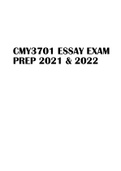
-
CMY3701 ESSAY EXAM PREP 2021 & 2022
- Exam (elaborations) • 35 pages • 2022
-
- R94,52
- + learn more
"Acquiring the disposition needed to commit crime is more important than learning the techniques used in committing crime" Analyse this statement in terms of Sutherland's nine propositions (30) Refer: CMY3701 Study Guide, pp. 98-102 Summary: •According to Sutherland the criminal behaviour was learned through social interactions , In order to describe this learning process , he developed the concept of differential association . There are 9 propositions which have been set in acc...
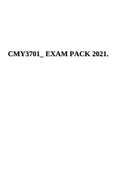
-
CMY3701 - The Explanation Of Crime EXAM PACK 2021.
- Exam (elaborations) • 157 pages • 2022
-
- R60,49
- + learn more
CMY3701 - The Explanation Of Crime EXAM PACK 2021. Question 1 The main strength of the differential association theory is that it showed that crime was not just a product of ___ but that it could occur in all settings. 1. learned behaviour 2. poverty 3. criminal attitudes 4. delinquency Answer: The correct answer is 2 Refer: CMY3701 Study Guide, pg. 102 Reasoning: “The main strength of the theory of differential association, according to Jones (2001:147), is that it showed that crime...
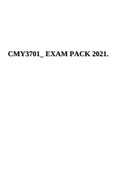
-
CMY3701_The_Explanation_of_Crime, EXAM PACK 2021.
- Exam (elaborations) • 157 pages • 2022
-
- R69,76
- + learn more
CMY3701_The_Explanation_of_Crime, EXAM PACK 2021.Question 1 The main strength of the differential association theory is that it showed that crime was not just a product of ___ but that it could occur in all settings. 1. learned behaviour 2. poverty 3. criminal attitudes 4. delinquency Answer: The correct answer is 2 Refer: CMY3701 Study Guide, pg. 102 Reasoning: “The main strength of the theory of differential association, according to Jones (2001:147), is that it showed that crime w...
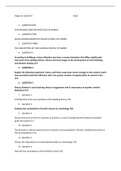
-
CMY3701_ ESSAY EXAM PREPARARIONS 2021.
- Exam (elaborations) • 34 pages • 2021
-
- R75,43
- + learn more
CMY3701_ ESSAY EXAM PREPARARIONS 2021. CMY3701 - The Explanation Of Crime. "Acquiring the disposition needed to commit crime is more important than learning the techniques used in committing crime" Analyse this statement in terms of Sutherland's nine propositions (30) Refer: CMY3701 Study Guide, pp. 98-102 Summary: •According to Sutherland the criminal behaviour was learned through social interactions , In order to describe this learning process , he developed the concept of different...
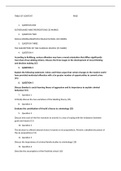
-
CMY3701 ESSAY EXAM PREPARARIONS 2021.
- Exam (elaborations) • 34 pages • 2021
-
- R65,97
- + learn more
TABLE OF CONTENT PAGE 1. QUESTION ONE SUTHERLANDS NINE PROPOSITIONS (30 MARKS) 2. QUESTION TWO SOCIAL DISORGANISATION CHICAGO SCHOOL (30 MARKS) 3. QUESTION THREE THE ASSUMPTION OF THE CLASSICAL SCHOOL (15 MARK) 4. QUESTION 4 According to Kohlberg, serious offenders may have a moral orientation that differs significantly from that of law-abiding citizens. Discuss the three stages in the development of moral thinking and decision making (15) 5. QUESTION 5 Explain the following statemen...

Do you wonder why so many students wear nice clothes, have money to spare and enjoy tons of free time? Well, they sell on Stuvia! Imagine your study notes being downloaded a dozen times for R250 each. Every. Single. Day. Discover all about earning on Stuvia


